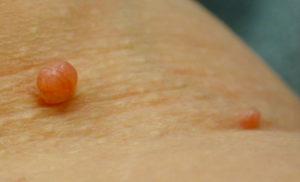Skin tags are usually more annoying to look at than anything else, but understanding what they are, and aren’t, can be reassuring. They are soft, small harmless, flesh-colored or slightly darker skin growths that are most commonly found on the neck, eyelids, the armpits, or the trunk — basically on areas of the body with folds. They may appear  elsewhere on the body as well. The cause is unknown, but they commonly appear after middle age. They begin as fleshy brown spots and may grow on a small stalk of stem. Skin tags never turn into skin cancer. The tendency to develop skin tags appears to be inherited (genetic). Some women develop skin tags during pregnancy.
elsewhere on the body as well. The cause is unknown, but they commonly appear after middle age. They begin as fleshy brown spots and may grow on a small stalk of stem. Skin tags never turn into skin cancer. The tendency to develop skin tags appears to be inherited (genetic). Some women develop skin tags during pregnancy.
Usually, skin tags cause no trouble, but they may be unattractive, and clothing or nearby skin may rub and irritate them as they bleed or hurt. A skin tag can be removed if it becomes irritated, bleeds, or causes embarrassment. It can easily remove by burning off with an electric needle or by cutting it off with a scalpel or scissors.
What Causes Skin Tag?
Skin tags are very common. About 25 percent of people will develop skin tags, usually starting after the age of 50. Skin tags are more common among people with diabetes as well as people who are overweight or obese — conditions that often go together.
The friction created by skin rubbing against skin, a side effect of being overweight, is what causes skin tags in certain people, and explains why skin tags often grow in body folds.
Repetitive friction and wearing tight clothes may contribute to skin tags in people who are overweight. According to a medical paper written by dermatologists in Spain, an obese patient, whose job required repeating lifting of her arms, developed a pattern of skin tags along her bra straps from the constant friction. Avoiding tight clothing if you are overweight is suggested.
Techniques used for skin tagging:
 Cutting Technique is used for all sizes of skin tags. The removal of the skin tags is permanent, this type of skin growth is often hereditary.
Cutting Technique is used for all sizes of skin tags. The removal of the skin tags is permanent, this type of skin growth is often hereditary.- Dotting Technique is used for common moles, age spots, ruby points, calcium deposits, and cholesterol deposits.
- Cross Hatch technique is used for flat moles and dark pigmentation on smooth skin.
Skin Tag Treatment Options
Depending on where your skin tags are located, you might not choose any skin tag treatment — out of sight can lead to out of mind. However, you might want to seek skin tag treatment for cosmetic reasons if, for instance, they are on your eyelids and detract from your appearance. Another reason to have a skin tag removed is if it is on an area that gets a lot of friction, even just from wearing clothes, causing irritation and bleeding.
 Skin tag treatment is relatively simple. Options include cryosurgery — removing the tag by superfreezing the skin — and cautery, burning off or destroying the tissue with heat. If the skin tag is indeed hanging, cutting it off with medical scissors is another option.
Skin tag treatment is relatively simple. Options include cryosurgery — removing the tag by superfreezing the skin — and cautery, burning off or destroying the tissue with heat. If the skin tag is indeed hanging, cutting it off with medical scissors is another option.
Because skin tags are considered harmless, the tissue is not usually analyzed after it’s removed the way a typical tumor would be. The exception is if a skin tag occurs on a child, because it could be the beginning of a condition called nevoid basal cell carcinoma syndrome, a rare genetic condition involving skin cancer.
There is no recovery time needed, and skin tag treatment usually leaves no trace of the tag — there shouldn’t be any scarring. However, although that skin tag doesn’t grow back, new skin tags may form. Skin tags can also be treated with lethal CO2 laser machine. Be sure to consult an expert dermatologist before this procedure.
While not at all dangerous, skin tags can be a nuisance or cosmetic woe. But if yours don’t bother you, it’s perfectly fine to ignore them. One word of caution: As with any changes on your skin, if the appearance of a skin tag changes, have it looked at by your doctor or dermatologist.

